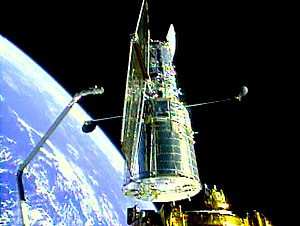Thu, Oct 16, 2008
So Far, So Good In Returning Observatory To Functional
Status
 NASA reports that Wednesday night,
Space Telescope Operations Control Center engineers at NASA's
Goddard Space Flight Center turned on and checked out Side 'B' of
Hubble's Science Instrument Control and Data Handling (SIC&DH)
system... powering up a backup system the space agency hopes will
return the orbiting observatory to near-full functionality.
NASA reports that Wednesday night,
Space Telescope Operations Control Center engineers at NASA's
Goddard Space Flight Center turned on and checked out Side 'B' of
Hubble's Science Instrument Control and Data Handling (SIC&DH)
system... powering up a backup system the space agency hopes will
return the orbiting observatory to near-full functionality.
As ANN reported, a transmission channel failed
September 27 on Hubble's Control Unit/Science Data Formatter, one
of many such systems used to relay data from Hubble to the ground,
where it is assembled into images. That caused the telescope to
revert to a safe mode... stopping all further data collection,
until a little-used backup system could be made ready.
The fault also resulted in NASA postponing a planned shuttle
flight to service the telescope, which was scheduled to launch
October 10.
NASA states that after the backup system was powered up
Wednesday, the Advanced Camera for Surveys (ACS), Wide Field
Planetary Camera 2 (WFPC2) and Near Infrared Camera and
Multi-Object Spectrometer (NICMOS) instruments were retrieved from
safe mode to establish that each has a working interface to the
Side B SIC&DH. The instruments were then commanded back into
safe mode, and will remain in that state until the SI C&DH
begins issuing commands to them, which NASA expected to do late
Thursday.
At around noon Thursday, NASA began transmitting commands to
recover Hubble's science instruments from their safe modes.
Internal exposures and calibrations of the telescope's science
instruments will occur before midnight Thursday.
Scientists at the Space Telescope Science Institute in Baltimore
should complete their review of the internal exposures by noon on
Friday, October 17. This procedure involves collecting and
comparing baseline exposures previously supported by Side A of the
SI C&DH to new exposures supported by Side B.
This review will be one last check of the "transparency" of
switching to the redundant spacecraft electronics the Hubble team
activated on Wednesday. A full schedule of science observations
with the WFPC2 camera, ACS' Solar Blind Channel camera, and the
Fine Guidance Sensors will resume early Friday morning... after
which time NASA hopes to report Hubble is operational once
again.
More News
Light Gun A handheld directional light signaling device which emits a brilliant narrow beam of white, green, or red light as selected by the tower controller. The color and type of>[...]
"The journey to this achievement started nearly a decade ago when a freshly commissioned Gentry, driven by a fascination with new technologies and a desire to contribute significan>[...]
Aero Linx: JAARS, Inc. For decades now, we’ve landed planes on narrow rivers and towering mountains. We’ve outfitted boats and vehicles to reach villages that rarely se>[...]
"Our driven and innovative team of military and civilian Airmen delivers combat power daily, ensuring our nation is ready today and tomorrow." Source: General Duke Richardson, AFMC>[...]
Aircraft Conflict Predicted conflict, within EDST of two aircraft, or between aircraft and airspace. A Red alert is used for conflicts when the predicted minimum separation is 5 na>[...]
 ANN's Daily Aero-Term (04.20.24): Light Gun
ANN's Daily Aero-Term (04.20.24): Light Gun Aero-News: Quote of the Day (04.20.24)
Aero-News: Quote of the Day (04.20.24) ANN's Daily Aero-Linx (04.21.24)
ANN's Daily Aero-Linx (04.21.24) Aero-News: Quote of the Day (04.21.24)
Aero-News: Quote of the Day (04.21.24) ANN's Daily Aero-Term (04.21.24): Aircraft Conflict
ANN's Daily Aero-Term (04.21.24): Aircraft Conflict



